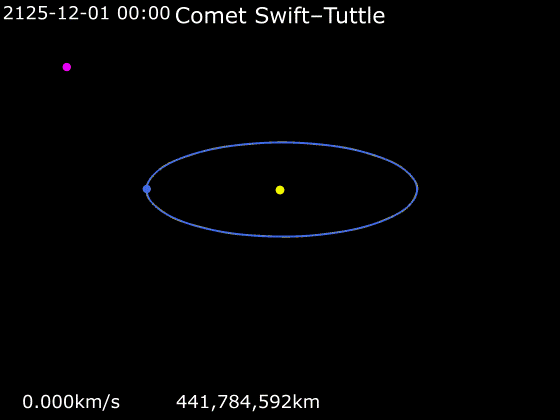Page 1 of 1
APOD: Perseid Rain (2021 Aug 15)
Posted: Sun Aug 15, 2021 4:05 am
by APOD Robot
 Perseid Rain
Explanation:
Perseid Rain
Explanation: Comet dust rained down on planet Earth last week, streaking through dark skies in the annual Perseid meteor shower. The featured picture is a composite of many images taken from the same location over the peak night of
the Perseids. The umbrella was
not needed as a shield from meteors, since they almost entirely
evaporate high in the
Earth's atmosphere. Many of the component images featured
individual Perseids, while one image featured the foreground near
Jiuquan City,
Gansu Province,
China. The stellar background includes the central band of our
Milky Way Galaxy, appearing nearly vertical, as well as the planets
Jupiter and
Saturn on the left. Although the
comet dust particles are traveling
parallel to each other, the resulting
shower meteors clearly seem to radiate from a single point on the sky -- the
radiant in the
eponymous constellation
Perseus. The image captured so long an angular field that the
curvature of the sky is visible in the trajectory of the
Perseids.
Re: APOD: Perseid Rain (2021 Aug 15)
Posted: Sun Aug 15, 2021 12:09 pm
by Case
What a creative composition! I like it.
Re: APOD: Perseid Rain (2021 Aug 15)
Posted: Sun Aug 15, 2021 12:23 pm
by orin stepanek
The term 'comet dust' reminds me of pixie dust;
so I looked looked up pixie! I expected a picture
of Tinker Belle; but I got was a bunch of women
with Pixie hairdos!

At any rate today's photo is
neat! I don't think the loving couple needed the
parasol though!

Re: APOD: Perseid Rain (2021 Aug 15)
Posted: Sun Aug 15, 2021 2:29 pm
by Rick
Hi all,
Lovely picture. Is there a way to save the image with out the pop up text? This question might be worthy of being on the FAQ list.
Warm regards, Rick.
Re: APOD: Perseid Rain (2021 Aug 15)
Posted: Sun Aug 15, 2021 2:58 pm
by orin stepanek
Rick wrote: ↑Sun Aug 15, 2021 2:29 pm
Hi all,
Lovely picture. Is there a way to save the image with out the pop up text? This question might be worthy of being on the FAQ list.
Warm regards, Rick.
Click ob the picture with the text, and you will get a picture without the notations!
Re: APOD: Perseid Rain (2021 Aug 15)
Posted: Sun Aug 15, 2021 3:10 pm
by neufer
orin stepanek wrote: ↑Sun Aug 15, 2021 12:23 pm
I don't think the loving couple needed the parasol though!

- They may need that parasol in 2126, however.
https://en.wikipedia.org/wiki/Comet_Swift%E2%80%93Tuttle wrote:
<<Comet Swift–Tuttle is a large periodic comet with a 1995 (osculating) orbital period of 133 years. Its nucleus is 26 km in diameter. Swift–Tuttle is the parent body of the Perseid meteor shower.
Chinese records indicate that, in 188, the comet reached apparent magnitude 0.1. After the 1862 observations it was thought that the comet would return between 1979 and 1983, but it didn't show up. However, it had been suggested in 1902 that this was the same comet as that observed by Ignatius Kegler on July 3, 1737, and on this basis Brian Marsden calculated correctly that it would return in 1992.
The comet's perihelion is just under that of Earth, while its aphelion is just over that of Pluto. An unusual aspect of its orbit is that it was recently captured into a 1:11 orbital resonance with Jupiter; it completes one orbit for every 11 of Jupiter. It was the first comet in a retrograde orbit to be found in a resonance. However, it only entered this resonance about 1000 years ago, and will probably exit the resonance in several thousand years.
The comet is on an orbit that makes repeated close approaches to the Earth-Moon system, and has an Earth-MOID (Minimum orbit intersection distance) of 0.0009 AU (130,000 km). Upon its September 1992 rediscovery, the comet's date of perihelion passage was off from the 1973 prediction by 17 days. It was then noticed that if its next perihelion passage (July 2126) was also off by another 15 days (July 26), the comet could impact the Earth on August 14, 2126.
Given the size of the nucleus of Swift–Tuttle, this was of some concern. This prompted amateur astronomer and writer Gary W. Kronk to search for previous apparitions of this comet. He found the comet was most likely observed by the Chinese in 69 BC and AD 188, which was quickly confirmed by Brian Marsden and added to the list of perihelion passages at the Minor Planet Center. This information and subsequent observations have led to recalculation of its orbit, which indicates the comet's orbit is sufficiently stable that there is absolutely no threat over the next two thousand years. It is now known that the comet will pass 0.153 AU from Earth on August 5, 2126. and within 0.147 AU from Earth on August 24, 2261.
Comet Swift–Tuttle is by far the largest near-Earth object (Apollo or Aten asteroid or short-period comet) to cross Earth's orbit and make repeated close approaches to Earth. With a relative velocity of 60 km/s, an Earth impact would have an estimated energy of ~27 times that of the Cretaceous–Paleogene impactor. The comet has been described as "the single most dangerous object known to humanity".>>
 Perseid Rain
Perseid Rain